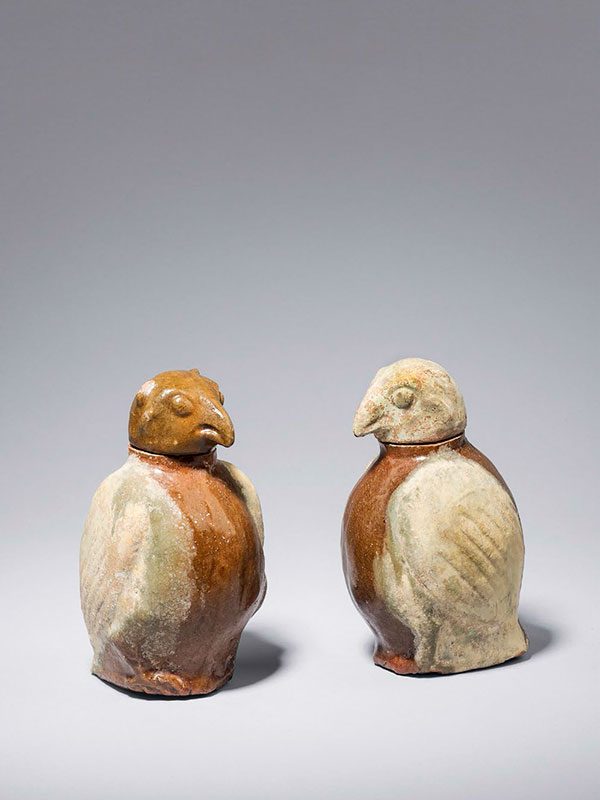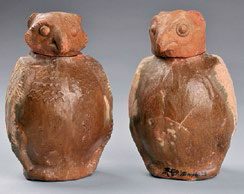Pair of owl-shaped pottery jars
A pair of pottery containers, each in the form of an owl with removable head. The birds aredepicted seated with their wings folded; the details of the claws and feathers are carefully rendered. The heads have pointed, curved beaks, small ears and bulging eyes. The red pottery is covered in brown and green lead glazes, which are applied with precision. The green colour has mostly become silvery iridescent.
Among the many animal motifs seen in early Chinese art the representation of the owl is one of the most prominent yet most mysterious images. The artistic development of pottery containers in the form of an owl can be traced back to the Neolithic time of the Yangshao culture (c. 5,500 – 3,500 BC).[1] Later, many Shang dynasty (c. 1600 – 1050 BC) bronze vessels were clearly inspired by the owl motif, either in the form of the vessel itselfor as surface decoration[2] – such as an owl-shaped zun whose head forms a removable lid in the Yale University Art Gallery collection.[3] It has been proposed by scholars that the mythical black-bird (xuanniao), from which the Shang people were believed to have originated, was an owl. Their terrifying screech and nocturnal behaviour would have fit perfectly the perception of abnormality in ritual and magic, hence they are most likely associated with the spiritual world. This pair of pottery owl containers is unusual in its highly naturalistic rendering of the birds. A pair of owl jars, closely comparable in glaze and form, was unearthed at Jiyuan, Henan province in 1969 and is now in the collection of the Henan Museum (fig. 1).[4] Two other related pairs of grey pottery owl containers with removable heads are respectively in the Yurinkan Museum in Japan[5] and the collection of H. M. King Gustaf Adolf VI of Sweden, the latter of which was exhibited at the British Museum in 1972.[6] A further comparable brown-glazed pottery owl figure, larger in size and dated to the Eastern Han dynasty, is in the Meiyintang collection.7
- Such as the pottery example unearthed from Shaanxi province in 1958, is now in the collection of the National Museum of China. See museum online collection: http:/ www.chnmuseum.cn/tabid/212/ Default.aspx?AntiqueLanguageID=638
- Wang, T. ‘The Owl in Early Chinese Art: Meaning and Representation’,
http://www.sothebys.com/en/ auctions/2014/sakamoto-n09124/sakamoto-goro/2014/02/the-owl-in-early-chi.html - Yale University Art Gallery online collection archive: http://artgallery.yale.edu/collections/objects/15960
- Zhongguo wenwu jinghua daquan – Taoci juan, Shangwu yinshu guan, Hong Kong, 1993, no. 290, p. 81
- Sato, Masahiko, Chugoku no dogu, Toji taikei, vol. 34, Bijutsu Shuppansha, Tokyo, 1965
- Gyllensvärd, B. Chinese Art from the collection of H.M. King Gustaf Adolf VI of Sweden, British Museum, 1972, no. 98, pp. 38 and 74
- Krahl, R. Chinese Ceramics from the Meiyintang Collection, vol. Three (I), Paradou Writing, London, 2006, no. 1159, p. 152
紅褐釉陶鴟鴞壺一對
漢 西元前206年 – 西元220年
高:14.2 公分
陶質器,中空,仿鴟鴞站立姿態塑成蓋壺,鴞頭為蓋,其身為壺,平底,通體施紅褐及綠釉。頭部雙目
圓突,雙耳微立,嘴成彎鉤狀。壺身塑出雙翼及爪,羽毛做波浪狀,形象逼真。鴟鴞(貓頭鷹)陶型
器源出自新石器時代仰韶文化,其後商代青銅器亦多以鴟鴞為飾,如現藏於美國耶魯大學美術館之商代
青銅鴞尊,以及婦好墓出土青銅鴞尊,均以鴟鴞為原型鑄造。學者研究指出,商代尊崇之玄鳥,原型
即為鴟鴞— 其懾人鳴聲及夜行習性均與上古巫術儀式的神秘氣氛相符,因此成為崇拜對象。河南濟源
軹城泗澗溝出土一對漢代紅綠釉陶鴞壺,為隨葬明器,不論尺寸、大小與型態均與本品極為相似,現
藏於河南省博物館。日本藤井有鄰館一對漢代綠褐釉鴞型壺及瑞典國王Gustaf Adolf VI藏一對陶製鴞
壺,均可茲比較。


